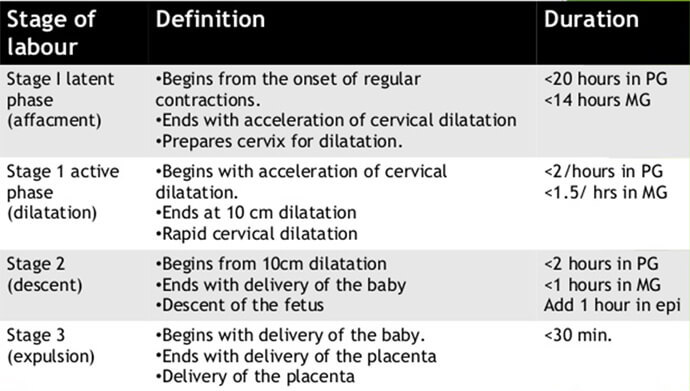
As your due date approaches, it is reasonable to ask how long the average delivery time for most females is. It could be in the hope of anticipating how long your labor and service period will last. The issue is that the duration of labor is not strict and rapid, as many variables can influence the length of childbirth.
What is the average labor time?

The duration and experience of each delivery depend on a range of variables for each female and every pregnancy. Factors that can influence the length of childbirth include:
- If you had a child (parity) before
- Your pelvis (form and dimension)
- The place of your baby
- Strength of contraction and timing
- Natural or induction labor
- Mother’s age (maternal age)
The first-time mothers in the first phase of their work usually experienced 6-12 hours (when four centimeters were dilated) with an average duration of 7.7 hours.
What are the stages of child delivery?

You will not understand how labor and birth will develop until it occurs. However, you can prepare by knowing the typical event sequence.
Stage 1: Early labor and active labor

The first stage of labor and birth occurs when intermittent contractions start to happen that cause the cervix to loosen up, relax, shrink, and thin. It enables the child to move into the canal of birth. The first phase of the three steps is the shortest. Indeed, it is split into two stages: early work (latent period) and active labor.
Early labor
Your cervix dilates and erases during early labor. You’re going to sense gentle, jagged contractions.
As your cervix starts to loosen, you might recognize that your vagina is bright, pink or slightly bloody. It is probably the mucus plug that blocks the opening of the cervix during pregnancy.
Early labor is inconstant. The average duration for first-time moms ranges from an hour to a day. For later deliveries, it is often shorter.
It is up to you until your contractions build up in recurrence and severity. Early labor is not particularly awkward for many females. Try to wait untroubled.
To encourage comfort during early labor:
- Walk.
- Take a bath or a shower.
- Listen to music.
- Try the techniques of breathing or relaxation taught by birth classes.
- Change position.
Your health provider will tell you when to go to the hospital or birth center. Call your doctor immediately if your water breaks or you encounter heavy vaginal bleeding.
Active labor
Now is the time to start the actual job. Your cervix will stretch from 6 centimeters (cm) to 10 cm throughout active labor. Your contractions will be more powerful, closer, and more consistent. The knees may cramp, and you may be nauseated. You can feel your water break— if it doesn’t exist already— and you will experience increased backpressure. If you are still not going to your work and distribution plant, now is the moment.
Don’t be astonished if your initial enthusiasm wanes with the labor and the pain escalates. Ask for anesthesia or pain medications if you want it. Your health care unit will partner with you so that you and your baby obtain the most suitable alternative. Remember, you can only judge your pain relief needs.
Giving Birth – How Long Does Labor Last
How long does it last: actual labor often takes 4 to 8 hours or longer. Your cervix dilates by an average of about one centimeter per hour.
The last piece of active labor— often perceived as a transition — can be exceptionally sharp and unpleasant. Contractions will close and last between 60 and 90 seconds. You will experience lower back and rectum pressure. Tell your doctor if you feel the desire to push.
Your healthcare supplier may ask you to stop if you want to push but are not entirely dilated. Too quickly, you could drive and swell your cervix, which may delay delivery. It usually takes 15 to 60 minutes to transition.
Stage 2: Your baby’s birth
During the second stage of labor, you will deliver your baby. It can take up to several hours or more to give birth to your baby. It might be even longer for moms and females who had an epidural for the first time.
Push! Your doctor will ask you to bear down or tell you when to push. Or if you feel the need, you may be advised to push.
Don’t keep tension in your face when you push. Stick and focus on pushing where it matters. Experiment with distinct roles if possible until you discover one that feels best. You can push, sit, kneel –even on your hands and knees.
At some stage, you may or may not be requested to press more softly. Slowing down provides time to extend rather than tear your vaginal tissues. You may want to touch the baby’s head among your legs to feel more energy or persistence.
The remainder of the baby’s body will follow soon after your baby’s head is delivered. If necessitated, your airway will be cleared. The umbilical cord is then sliced by your health care provider or labor coach.
Stage 3: Placenta delivery
You will probably feel an incredible feeling of relief when your child is born. You may keep the child in your arms or abdomen. Cherish the moment. Cherish the moment. But there is still a lot going on. You will deliver the placenta during the third phase of work.
Typically the placenta is fulfilled in five to 30 minutes, but the system may take up to an hour. Your focus has probably moved into your child by now. You may be unaware of what is happening around you. Try breastfeeding your child if you want.
You will still have gentle contractions. They will be near and less painful together. Also, you will be told to push the placenta again. You may be provided medication before or after the placenta to promote uterine contractions and minimize bleeding.
The placenta will be examined by your health care supplier to make sure it is intact. Any remaining pieces of the uterus must be separated to avoid bleeding and infection.
Read also:
- Giving Birth – How Long Does Labor Last
- How Membrane Sweeping Helps Induce Labor?
- Natural Ways On How To Speed Up Labor During Pregnancy


